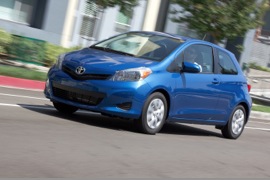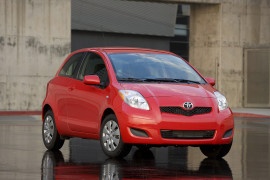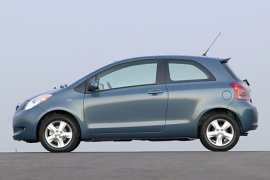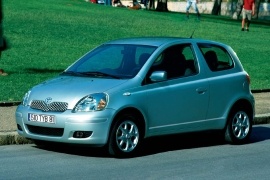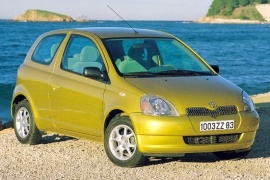TOYOTA Yaris 3 Doors Models/Series Timeline, Specifications & Photos
First production year: 1999
Engines: Gasoline, Diesel
Body style: Hatchback
The small GRMN was the Toyota’s inspired rally car, the Toyota Yaris WRC. The GRMN nameplate was actually an acronym from the Gazoo Racing Master of Nurburgring.
The GRMN had a unique exterior paint with red and black stripes. While it still looked pretty much similar to the Yaris, but with a more aggressive design and a big rear spoiler.
Inside the GRMN were chunky sport seats that were very comfortable aluminum pedals to complete the sports look. The steering wheel was also different from the one on the regular Yaris.
The back seats had limited headroom and legroom, not suitable for full grown ups.
The interior was pretty much designed to be driver-focused.
Under the hood of the GRMN we could find a supercharged 1.8-liter petrol engine that developed 212 HP. The only more powerful car in its segment at that time was the Renault Clio 4.
Lots of parts were replaced to achieve the GRMN’s performance, including the suspension that became better, lower and stiffer at the same time.
The steering was really fast and pretty accurate, however, it did not offer as much feedback as a true sports car did.
The small GRMN handled really well in turns with almost no body roll.
Buying a GRMN would be a difficult task, as only 600 units were produced worldwide, while only 80 of them entered the UK in 2018.
After three years on the market, the Yaris went through some significant changes that completely revamped the small-sized Toyota vehicle.
Despite being well-known for its built quality, Toyota struggled to get a better market share in Europe due to the fierce competition against local carmakers. Apart from the premium manufacturers, all the other brands had something to offer in the B-segment.
While the Japanese carmaker was known for its reliable vehicles, it still had to struggle in the small-size segment. In Europe, it faced grueling competition from the German, French, Italian, and Spanish brands. Even though its customers were satisfied with the car, they still needed something more than just a nameplate; they needed a fresh look. And that's why Toyota came in 2014 with the upgraded version of the Yaris' third generation.
The most significant change in the car's appearance was at the front. Toyota's design team completely changed the front fascia, which now featured an X-shaped design emphasized by two chromed trims that ran across the grille and the lower bumper. In addition, the new headlights looked even sharper than before and were more extended to the sides. From its profile, the little three-door Yaris got longer doors than its five-door version, and for the rear passengers, it installed narrower windows.
Inside, the dashboard was completely redesigned, and the driver's instrument binnacle has been restyled for a slimmer look. On the center stack, the carmaker offered an option for a 7" touch-screen display for the infotainment unit, up from the 6.1" of its predecessor. As for the interior decorations, the carmaker offered new upholstery and colors.
Under the hood, the carmaker kept some of its older engines but ditched the 1.6-liter turbo-diesel in favor of a smaller 1.4-liter unit. In addition, a new hybrid version was available.
The third generation of the Toyota Yaris was introduced in 2011 and it came to reinforce the Japanese car-maker presence in the European B-Segment.
The big competition for the small segment was high in Europe. The European traditional car-makers such as the French, Italians and German companies were hard to beat on their home ground. The 2011 Yaris delivered an ingenious combination of benefits, with hi-tech on-board equipment and decent engine offers.
When compared to its predecessor, the 2011 Yaris grew with 100 mm (3.9”) and half of the increase was in the wheelbase. The bold frontal look identified the Yaris as the first vehicle to feature the new face of the Toyota family. The key frontal styling was the change in the proportions of the upper and lower grilles. The taillights were placed into an angled position, at the mid-section of the tailgate. The trunk was larger than on its predecessor by 25%. For the three-door version, the rear windows were fixed.
Inside the vehicle, there were more than enough amenities for the B-segment car. A climate control, on-board computer, and a sound system. The latter could have been upgraded to a genuine infotainment unit that featured the Toyota Touch multimedia base unit. Using a compatible smartphone, via Bluetooth, the system offered on-board connectivity to Google Local Search function, Google Maps, Facebook and SMS text services. In the rear, there was room for three passengers with a limited legroom for the one in the middle.
For the engine compartment, there were options for gasoline and diesel units. In the U.S. a 1.5-liter unit was available. A 5-speed manual was standard, while an automatic with up to 7 speed was available depending on the engine.
The small city car proved to be one of the most fuel-efficient options on the market, and Toyota introduced the facelifted Yaris in 2008.
Both the 5-door and the 3-door hatchback body styles were refreshed in terms of exterior design and mechanicals.
The carmaker had to work and add some changes to the drivetrain and fit the car within the Euro 5 emission limits, which were mandatory from January 2009.
At the front, Toyota changed the headlights with clear-glass covers and introduced a mesh-grille design. Depending on the trim level and options, the carmaker installed fog-lights at the bottom of the front bumper or just left black caps instead of them. In the rear, the taillights received a slightly modified design. Toyota offered the Yaris range with a choice of 12 colors, including a new "Ash-Brown."
Inside, the carmaker completely changed the dashboard. It moved the instrument cluster in front of the driver, while its predecessor it installed in the middle of the dash. Toyota made some changes to the upholstery and added a few colors to the options list. A few silver trims around the center stack, steering wheel, and gear-stick enhanced the interior look.
For the drivetrain, Toyota installed a new 1.33-liter Dual VVT-i gasoline engine under the Yaris' hood. To further reduce the CO2 emissions, it added the "Stop&Start" technology. It was paired as standard to a 5-speed manual while an automated gearbox was on the options list.
Toyota introduced the second generation of the Yaris in 2005 for both European and North American markets and made it available with either five or three doors.
Yaris tried to disrupt the supermini segment with its vast interior space and soft look. In addition, it counted on Toyota's reputation for building reliable cars. But despite these, it lacked behind its European competitors, especially in the three-door version.
Penned as a cute-looking vehicle, the Yaris' front fascia featured a pair of headlights relatively vertical than horizontal and a grill that looked like a scaled-down version of the one featured on the larger Avensis. Thanks to the short overhangs and the tall, bubble-like greenhouse, it offered an airy interior. From its profile, the long doors eased access for all passengers. Finally, at the back, the car featured an almost vertical drop on the tailgate but with a rounded shape.
Inside, the carmaker placed a hard-plastic dashboard fitted with multiple storage spaces in front of the driver and three more on the passenger's side. That was possible thanks to the center-mounted instrument cluster, which provided all passengers aboard a good view of the speedometer. For the rear seats, Toyota installed a split-folding and sliding bench. Thus, it could offer better legroom or bigger trunk space when needed.
Under the hood, the carmaker installed a choice of three engines: two with gasoline and one turbo-diesel paired with a five-speed manual as standard. For specific markets and engines, the Yaris was also available with a five-speed automatic transmission.
With the great success of the 1999 models, Toyota decided it was time for a redesign of the Yaris. The refreshed version was released in 2003.
The new design was meant to create a better looking car, while still keeping some of the original Yaris.
The front bumper, along with the radiator grille and the headlights were refreshed to give a sportier look. At the rear, the bumper was restyled.
A new Color Collection was available for the facelift Yari, and it stood out with the metallic paint finish and other features such as front fog lamps, a chrome exhaust pipe, alloy wheels and color-matching door mirrors and bumpers.
The users could choose from Twilight Blue, Carlo Blue, Thunder Grey, Eclipse Black and Crystal Silver only for the 1.0-liter and the 1.3-liter VVT-i gasoline engines.
The engines mentioned above were mated with a 5-speed manual transmission.
The body structure was revised to improve safety, along with the ride quality and the car’s dynamics. The NVH (Noise, Vibration, Harshness) level was reduced and the Yaris felt more like a larger car.
The interior of the Yaris was roomy for such a small car, with both the front and the rear passengers benefiting of great comfort.
With a decent trunk size for a car in its class, the Yaris also had foldable rear seats (with a 60:40 configuration) to extend the load area if necessary.
Toyota didn’t have much success in the European supermini segment, but things changed when the Yaris came to life.
The Toyota Yaris was revealed to the public in 1999 as a 3-door or a 5-door hatchback.
To make sure that the small car would appeal to the Europeans, they had the Yaris designed in Europe.
The Yaris featured a high roof and a low floor that ensured easy access, as well as great headroom for all its occupants.
Aesthetically, the small Yaris didn’t really look high-fashioned but had a rather happy exterior design with the oversized headlamps and the chromed grille integrated into the hood.
Inside, the traditional dashboard was replaced by a center pod with a digital information display. The carmaker considered that it was safer since the driver could keep an eye on the screen and still be able to see the road ahead. Nissan tried the same layout with the Primera and it didn't work well. The drivers had a different habit and they didn't want to change it.
The interior felt solid and looked well-built, however, the grey plastics used gave the cabin a dull look.
Space-wise, the Yaris’ cabin could fit 4 adults in great comfort.
When Toyota built the Yaris, they did it with three words in mind: affordable, economical, and practical. Thus, regardless of the engine choice,1.0-liter or 1.3-liter, the Yaris came with low fuel consumption and enough power for city driving.
Depending on the trim level, the Yaris could come equipped with air-conditioning, alloy wheels and a CD radio, power steering, and others.
Toyota's Yaris won the European Car of the Year in 2000, to the detriment of Fiat Multipla and Opel Zafira.


